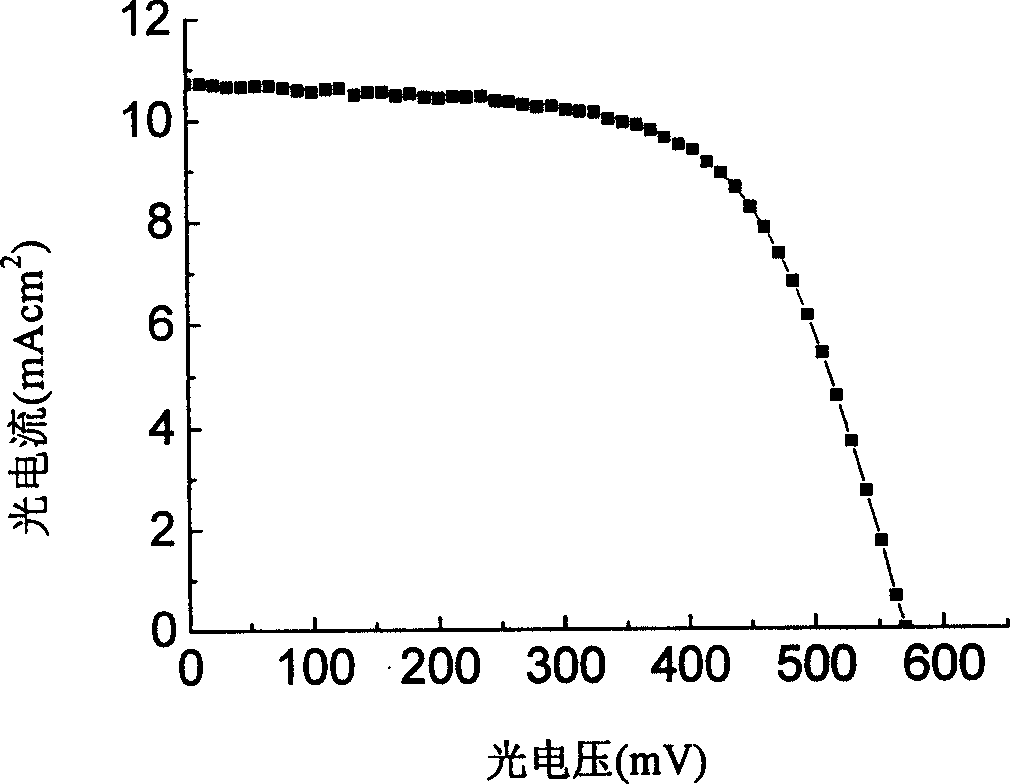Quasi-solid-state dye sensitized nano crystal salar battery and manufacturing method thereof
A technology of solar cells and dye sensitization, which is applied in the field of dye-sensitized nanocrystalline solar cells, and can solve problems affecting the long-term stability of batteries, leakage, and volatilization of liquid electrolyte solvents
- Summary
- Abstract
- Description
- Claims
- Application Information
AI Technical Summary
Problems solved by technology
Method used
Image
Examples
Embodiment 1
[0025] Example 1: Place the titanium dioxide nanocrystalline film electrode on 5×10 -4 Mole / liter N 3 Soak in the dye solution for 24 hours for sensitization. Then drop 0.1 mL of liquid electrolyte, the composition is 0.1 mol / liter I 2 , 0.1 mol / L LiI, 0.5 mol / L 4-tert-butylpyridine, 0.6 mol / L 1-methyl-3-propylimidazole iodide salt, and then put a piece of platinum-coated ITO glass on the dye-sensitized Dye-sensitized solar cells were assembled on the nano-titanium dioxide crystal film and measured. At 80mW / cm 2 The open-circuit photovoltage of the battery is 570mV and the short-circuit photocurrent is 10.7mA / cm under the white light irradiation. 2 , The fill factor is 0.62 and the energy conversion efficiency is 4.7%.
Embodiment 2
[0026] Example 2: Place the titanium dioxide nanocrystalline film electrode on 5×10 -4 Mole / liter N 3 Soak in the dye solution for 24 hours for sensitization. Then drop 0.1 mL of quasi-solid electrolyte, the composition is 0.1 mol / liter I 2 , 0.1 mol / L LiI, 0.5 mol / L 4-tert-butylpyridine, 0.6 mol / L 1-methyl-3-propylimidazole iodide salt, 0.05% (mass fraction) of mesoporous silica, and then A piece of platinum-plated ITO glass is placed on the dye-sensitized nanometer titanium dioxide crystal film to assemble the dye-sensitized solar cell and perform measurement. At 80mW / cm 2 The open-circuit photovoltage of the battery is 584mV and the short-circuit photocurrent is 6.9mA / cm under the white light irradiation. 2 , The fill factor is 0.68, and the energy conversion efficiency is 3.4%. See the photocurrent and photovoltage curves image 3 Shown.
Embodiment 3
[0027] Example 3: Place the titanium dioxide nanocrystalline film electrode on 5×10 -4 Mole / liter N 3 Soak in the dye solution for 24 hours for sensitization. Then drop 0.1 mL of quasi-solid electrolyte, the composition is 0.1 mol / liter I 2 , 0.1 mol / L LiI, 0.5 mol / L 4-tert-butylpyridine, 0.6 mol / L 1-methyl-3-propylimidazole salt, 3% (mass fraction) of mesoporous silica, and then add a piece of The platinum-plated ITO glass is placed on the dye-sensitized nano titanium dioxide crystal film, and the dye-sensitized solar cell is assembled and measured. At 80mW / cm 2 The open-circuit photovoltage of the battery is 587mV and the short-circuit photocurrent is 6.7mA / cm under the white light irradiation. 2 , The fill factor is 0.68, and the energy conversion efficiency is 3.4%. See the photocurrent and photovoltage curves Figure 4 Shown.
PUM
 Login to View More
Login to View More Abstract
Description
Claims
Application Information
 Login to View More
Login to View More - R&D
- Intellectual Property
- Life Sciences
- Materials
- Tech Scout
- Unparalleled Data Quality
- Higher Quality Content
- 60% Fewer Hallucinations
Browse by: Latest US Patents, China's latest patents, Technical Efficacy Thesaurus, Application Domain, Technology Topic, Popular Technical Reports.
© 2025 PatSnap. All rights reserved.Legal|Privacy policy|Modern Slavery Act Transparency Statement|Sitemap|About US| Contact US: help@patsnap.com



